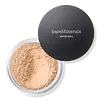Pur Cosmetics 4-In-1 Pressed Mineral Makeup Broad Spectrum SPF 15 Versus bareMinerals Original Loose Powder Foundation SPF 15
What's inside
What's inside
 Key Ingredients
Key Ingredients

 Benefits
Benefits

 Concerns
Concerns

 Ingredients Side-by-side
Ingredients Side-by-side

Titanium Dioxide 9%
Cosmetic ColorantMica
Cosmetic ColorantCI 77163
Cosmetic ColorantCaprylic/Capric Triglyceride
MaskingBoron Nitride
AbsorbentZinc Stearate
Cosmetic ColorantMagnesium Silicate
AbsorbentSodium Starch Octenylsuccinate
AbsorbentMannitol
HumectantSodium Gluconate
Skin ConditioningCitric Acid
BufferingSodium Citrate
BufferingWaltheria Indica Leaf Extract
Skin ConditioningDextrin
AbsorbentFerulic Acid
AntimicrobialLactic Acid
BufferingButyrospermum Parkii Butter
Skin ConditioningRetinol
Skin ConditioningCeramide AP
Skin ConditioningSilica
AbrasiveTocopheryl Acetate
AntioxidantWater
Skin ConditioningGlucosamine Hcl
Pisum Sativum Extract
Skin ConditioningBambusa Vulgaris Leaf/Stem Extract
HumectantMagnesium Carbonate
AbsorbentIron Oxides
CI 77491
Cosmetic ColorantCI 77492
Cosmetic ColorantCI 77499
Cosmetic ColorantCI 77891
Cosmetic ColorantCI 77007
Cosmetic ColorantTitanium Dioxide 9%, Mica, CI 77163, Caprylic/Capric Triglyceride, Boron Nitride, Zinc Stearate, Magnesium Silicate, Sodium Starch Octenylsuccinate, Mannitol, Sodium Gluconate, Citric Acid, Sodium Citrate, Waltheria Indica Leaf Extract, Dextrin, Ferulic Acid, Lactic Acid, Butyrospermum Parkii Butter, Retinol, Ceramide AP, Silica, Tocopheryl Acetate, Water, Glucosamine Hcl, Pisum Sativum Extract, Bambusa Vulgaris Leaf/Stem Extract, Magnesium Carbonate, Iron Oxides, CI 77491, CI 77492, CI 77499, CI 77891, CI 77007
 Reviews
Reviews

Alternatives
Ingredients Explained
These ingredients are found in both products.
Ingredients higher up in an ingredient list are typically present in a larger amount.
This synthetic powder is used to add a pearly/white color in cosmetics.
Mica is a naturally occurring mineral used to add shimmer and color in cosmetics. It can also help improve the texture of a product or give it an opaque, white/silver color.
Serecite is the name for very fine but ragged grains of mica.
This ingredient is often coated with metal oxides like titanium dioxide. Trace amounts of heavy metals may be found in mica, but these metals are not harmful in our personal products.
Mica has been used since prehistoric times throughout the world. Ancient Egyptian, Indian, Greek, Roman, Aztec, and Chinese civilizations have used mica.
Learn more about MicaTitanium dioxide is a mineral UV filter widely used in sunscreens and cosmetics.
It is one of only two UV filters officially classified as “mineral” by regulatory agencies, the other being zinc oxide.
Titanium dioxide provides broad-spectrum protection mostly in the UVB and UVAII range, with some protection in the UVAI range.
While its UVA protection isn’t as strong as zinc oxide’s, the difference is minor.
A common myth is that mineral UV filters reflect UV light. However, modern research shows titanium dioxide absorbs UV radiation like chemical filters (~95% absorption & 5% reflection).
Thanks to its non-irritating nature, titanium dioxide is suitable for sensitive, acne-prone, or redness-prone skin. It is unlikely to cause "eye sting" like other sunscreen ingredients.
A major drawback of this ingredient is its white cast and thick texture. This is why mineral sunscreens often leave a white cast and are less cosmetically elegant than chemical/hybrid sunscreens.
To improve white cast and spreadability, micronized or nano-sized titanium dioxide is often used.
There are ongoing concerns surrounding nano-titanium oxide's impact on marine ecosystems.
There is no conclusive evidence that any form of titanium oxide (or any other sunscreen ingredients) will cause harm to marine ecosystems or coral reefs. The science is still developing but many consumers are keeping a close eye on this issue.
Please note, many destinations have reef-safety sunscreen rules. For instance, the U.S. Virgin Islands advises all visitors to use non-nano mineral sunscreens.
Nano mineral sunscreens once raised safety concerns about absorption into skin.
Extensive research has shown that they do not penetrate healthy or damaged skin; they remain safely on the surface and the top layer of dead skin (stratum corneum).
You'll likely find titanium dioxide bundled with alumina, silica, or dimethicone. These ingredients help make titanium dioxide highly photostable; this prevents it from interacting with other formula components under UV light.
Learn more about Titanium DioxideThis ingredient is a combination of red, black, and yellow iron oxide pigments. This combination of colors is usually found in foundation, because it results in a "skin" color.